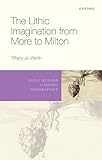The lithic imagination from more to Milton / Tiffany Werth.
Series: Early modern literary geographies - clothPublisher: New York : Oxford University Press, 2024Description: pages cmContent type:- text
- unmediated
- volume
- 9780198903963
| Item type | Current library | Status | Barcode | |
|---|---|---|---|---|
 Open Access Books - Publishers
Open Access Books - Publishers
|
National Law School | Available | OABP461 |
"The Lithic Imagination from More to Milton explores how stones, rocks, and the broader mineral realm, play a vital role in early modern England's religious and cultural systems that in turn informs the period's poetic and visual imagination. The twin buttresses of a human lifespan and the gyre-like turns of England's long Reformation provide a broad dome under which to locate the many textual and visual archives this book studies. These texts and images participate in specifically English histories (literary, artistic, political, religious) although continental influences are frequently in dialogue. The religious orbit tracks the rivalries firstly between Jewish and Christian culture, touches on Christianity's tension with Islam, but most intently follows the antagonisms of Catholic and variants of Reformed or Protestant belief. The bibliography features canonical names such as Shakespeare, Spenser, Donne, Wroth, Herbert, Milton, and Pulter, but puts them in company with lesser-known religious polemicists, alchemists, anatomists, painters, mothers, and stone masons. The visual archive attends to biblical illustration, tapestries, church furniture, and paintings, anatomical drawings, as well as statues to form a multi-media archive. Similarly, the lithic embraces a wide continuum of mineral forms from bodily encrustations like the kidney and bezoar stone, to salt, iron, limestone, marble, flint, and silicon. The assemblage of materials speaks to aspirational imperial fantasies, looming colonial conquests, syncretism and supersession, as well as issues of gender and the race-making category of hue, alongside elitist ideologies of an elect, chosen people. All connect via the storied pathways of stone as densely material and a foundation for the abstract imaginary along the scala naturae. Across these human-stone encounters, stone fascinates and betrays and is equal parts damnation and salvation"-- Provided by publisher.
There are no comments on this title.
